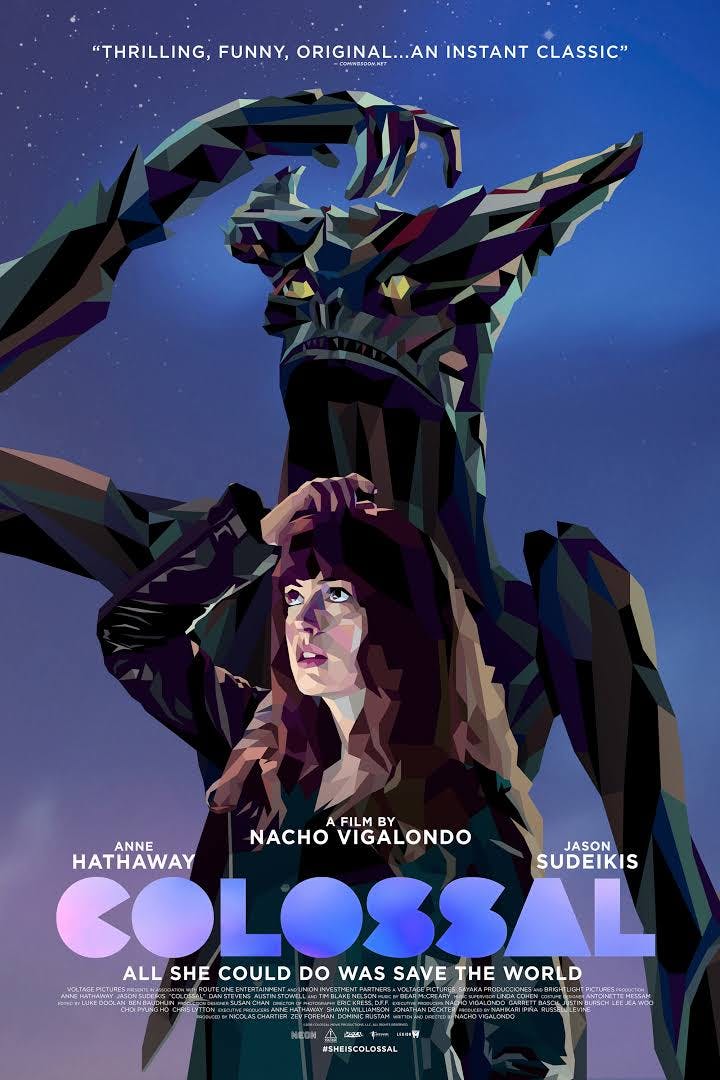It was a dark and stormy night. At the AMC Lincoln Square theater, PR girls in summery dresses and wet hair rushed around trying to keep the New York opening of Nacho Vigalondo’s new film Colossal from soupifying completely. A staffer told guests which theater to head for by repeating “Majestic, Colossal, Majestic, Colossal, Majestic, Colossal” like a hyperbolic adjective automaton.
Hollywood has been hyperbolic lately, particularly with its monsters. A friend tried to tempt me to see Kong: Skull Island by pointing out that “Kong is larger than usual.” A Monster Calls is about just that. The new live-action Beauty and the Beast pits poor Belle against a CGI monster who looks about eight feet tall. Jia Tolentino asked in the New Yorker this week the question that surely has been on all our minds since seeing this animated beast: What’s his dick like?

Anne Hathaway plays Colossal’s protagonist Gloria, a minor-league drunk who leaves New York for her hometown after her uppity boyfriend (Dan Stevens) kicks her out. There, she reconnects with her childhood friend Oscar (Jason Sudeikis), who gives her a job at his bar and, it seems, a shot at rural love. His two mates, played by Austin Stowell and the ferociously underrated Tim Blake Nelson, hover in the background.
But just as Colossal settles into a familiar groove, it changes gears. Gloria soon realizes that she is inadvertently controlling the movements of a daikaiju (enormous monster) terrorizing Seoul at 8:05 A.M. each morning. She figures this out during one of her frequent hangovers (Gloria repeatedly wakes up in horribly uncomfortable positions, having failed to inflate her mattress) and verifies her suspicion by comparing her gestures of the previous night with the monster’s, which she sees on the news. Gloria’s realization that she is stomping mindlessly on hundreds of innocent Korean citizens while drunk comes packaged as a kind of wincing what did I do last night? recollection. Like The Hangover mixed with Godzilla.
As she tries to figure out how not to engage in mass carnage, Gloria grows closer to Oscar. Oscar has a beard and one of those shearling jackets that signify rugged American simplicity in movies. Remember, her New York boyfriend was uppity—British, and named Tim. Maybe Oscar, who has followed Gloria’s New York career online and clearly never forgotten her, is the prince to save our giant?
Oscar has remodelled his father’s bar after inheriting it. It had been country and western-ish, but the new look is modern and metallic. Half the place is blocked off by a makeshift wall. Intrigued, Gloria pushes past the wall. There she finds the old version of the family bar, untouched: Oscar’s remodelling only went halfway across the room. Gloria is charmed. “It’s like a Wes Anderson movie in here!” she exclaims.
Just as Wes Anderson recycles outdated styles (in music, interiors, and filmmaking) to cute “vintage” effect, Gloria sees the old bar as “ironic,” a parody of small-town masculinity. But this is a mistake. In a startlingly original reversal that divides the movie into two halves, Oscar proves himself a small-minded, small-hearted, small-town man. He has followed Gloria’s New York career not out of wonder, but resentment. What if The Hangover not only met Godzilla, but also Sleeping With the Enemy? Vigalondo may be the first filmmaker to have wondered.
One poster for Colossal bears the slogan, “There’s a monster in all of us.” For Gloria, the kaiju is clearly in one sense her drinking. But the monster only materializes when she is at home; he was born somewhere in her past, her childhood. Is the monster in fact her rage, and, if he is, her rage over what? Vigalondo offers some hints. As Oscar turns monstrous over the course of the film, Colossal becomes a narrative about men who wish they were big and powerful, and what it is like to live in their world. It’s all there in the dark half of the bar.
The motif of a remodelled interior symbolizing American masculinity (misinterpreted by heroine to tragic effect) may seem over-complex. But there are simpler joys. The daikaiju genre has survived the test of time for a reason. And it is no great spoiler to say that, later on, a giant robot appears. The overall effect is a little as if Nacho Vigalondo watched the video for The Beastie Boys’ “Intergalactic” and thought, “Aha, but what if … gender?”
As my friend whispered to me while the credits rolled, it does feel extraordinary to see a movie where the small-town guy does not symbolize goodness. There is a story in Angela Carter’s 1979 collection The Bloody Chamber called “The Tiger’s Bride.” In it, a young woman moves in with a very beastly man who eventually turns out to be a tiger. In the end, the woman becomes a tiger herself; they live together, not afraid of their own natures. Colossal is more like “The Tiger’s Bride” than Beauty and the Beast. Through a hyper-formal tale of inversion and genre-based surprises, Colossal returns its heroine to herself. Genres and archetypes can be dangerously misleading, Vigalondo seems to say. It is better to be a city-stomping monster and to know oneself than to be walked all over in a sad old story.
